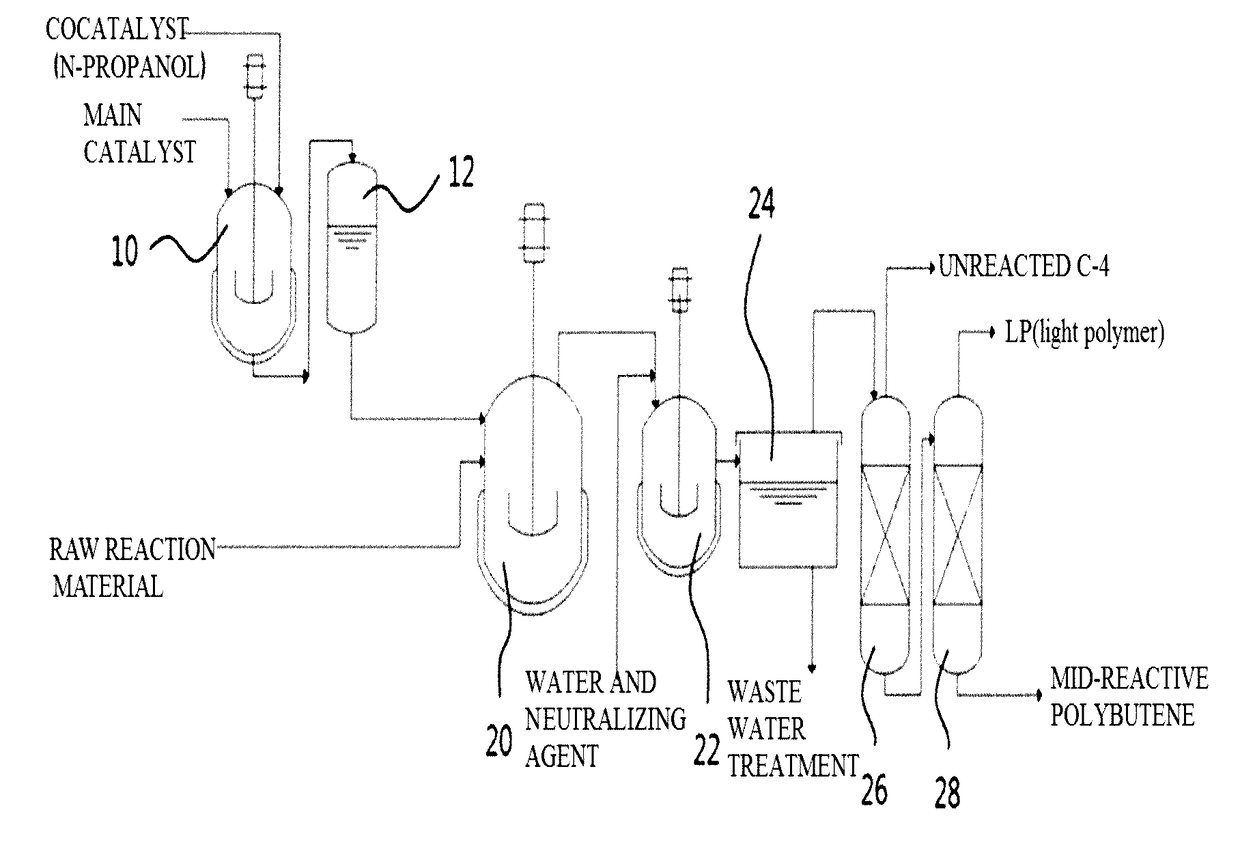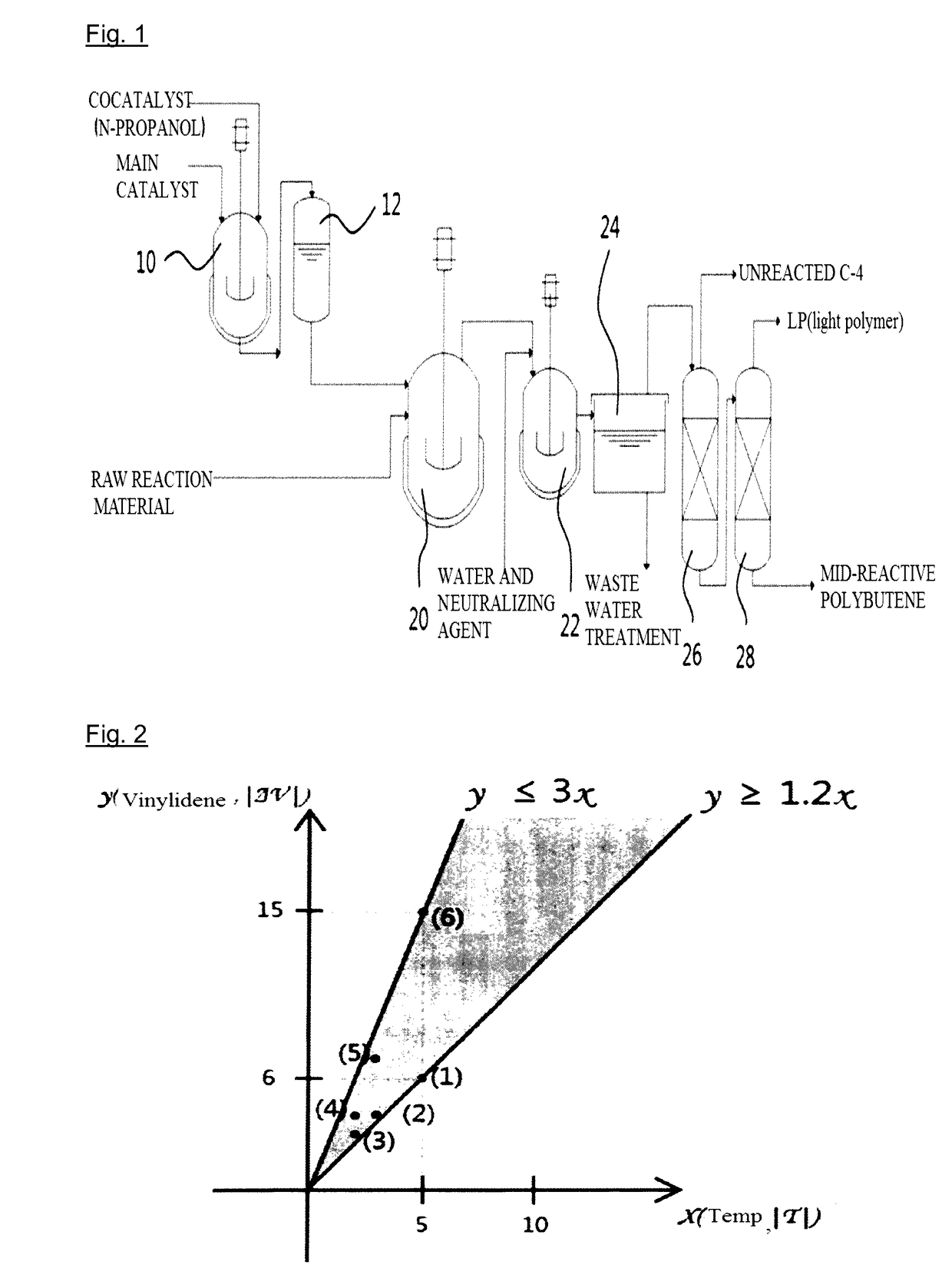Method for Preparing Polybutene by Using Catalyst Containing N-Propanol
a technology of n-propanol and catalyst, which is applied in the field of preparing polybutene, can solve the problems of large amount of light polymer (lp), -reactive polybutene, and the yield of pibsa, and achieve the effects of high conversion ratio and yield
- Summary
- Abstract
- Description
- Claims
- Application Information
AI Technical Summary
Benefits of technology
Problems solved by technology
Method used
Image
Examples
example 1
[Example 1] Polymerization of Mid-Reactive Polybutene Having Molecular Weight of Grade 1,000
[0041]Polymerization was performed by continuously introducing a complex catalyst of normal propanol / boron trifluoride having a molar ratio of 1.1, which is prepared in a complex catalyst preparation device, and a raw reaction material having composition as described in Example 1 in Table 1 below (C4 raffinate-1), while maintaining the temperature of a reactor at −6° C. To allow the raw reaction material to maintain a liquid state, the pressure of the reactor was maintained at 3 kg / cm2 or more. The average retention time was 45 minutes. In terms of the amount of used catalyst, 0.1 parts by weight of boron trifluoride was introduced with respect to 100 parts by weight of isobutene. After 180 minutes, the reactant released from the reactor was mixed with 5 wt % of a sodium hydroxide solution, and transferred to a neutralization and washing bath to terminate polymerization and remove the catalys...
example 2
[Example 2] Polymerization of Mid-Reactive Polybutene Having Molecular Weight of Grade of 1,000
[0042]To obtain mid-reactive polybutene, polymerization was performed as described in Example 1 except that the reaction temperature was maintained at −6° C.; a raw reaction material having composition as described in Example 2 in Table 1 above (i.e., pure isobutylene) was used; and 0.08 parts by weight of boron trifluoride was introduced with respect to 100 parts by weight of isobutene. The isobutene conversion rate was 97%, and the vinylidene content was 63%. In addition, the tetra-substituted double bond content was 18% (number average molecular weight (Mn)=980).
example 3
[Example 3] Polymerization of Mid-Reactive Polybutene Having Molecular Weight of Grade 1,000
[0043]To obtain mid-reactive polybutene, polymerization was performed as described in Example 1 except that the reaction temperature was maintained at −8° C.; a raw reaction material having composition as described in Example 3 in Table 1 above (i.e., butane-butene oil (B-B oil)) was used; and 0.17 parts by weight of boron trifluoride was introduced with respect to 100 parts by weight of isobutene. The isobutene conversion rate was 88%, and the vinylidene content was 56%. In addition, the tetra-substituted double bond content was 25% (number average molecular weight (Mn)=960).
PUM
| Property | Measurement | Unit |
|---|---|---|
| temperature | aaaaa | aaaaa |
| molar ratio | aaaaa | aaaaa |
| temperature | aaaaa | aaaaa |
Abstract
Description
Claims
Application Information
 Login to View More
Login to View More - R&D
- Intellectual Property
- Life Sciences
- Materials
- Tech Scout
- Unparalleled Data Quality
- Higher Quality Content
- 60% Fewer Hallucinations
Browse by: Latest US Patents, China's latest patents, Technical Efficacy Thesaurus, Application Domain, Technology Topic, Popular Technical Reports.
© 2025 PatSnap. All rights reserved.Legal|Privacy policy|Modern Slavery Act Transparency Statement|Sitemap|About US| Contact US: help@patsnap.com



